The mesothorax, or middle segment of the thorax, which is two or three times larger in diameter, is flattened in front and separated from the nipple formed by the prothorax and the head by a deep, narrow, curved fissure. On its front surface are two pale red stigmata, or respiratory orifices, placed pretty close together. The metathorax, or last segment of the thorax, is a little larger still in diameter and protrudes. These abrupt increases in circumference result in a marked hump, sloping sharply towards the front. The nipple of which the head forms part is set at the bottom of this hump.
After the metathorax, the shape becomes regular and cylindrical, while decreasing slightly in girth in the last two or three segments. Close to the line of separation of the last two rings, I am able to distinguish, not without difficulty, two very small stigmata, just a little darker in color. They belong to the last segment. In all, four respiratory orifices, two in front and two behind, as is the rule among Flies. The length of the full sized larva is 15 to 20 millimeters and its breadth 5 to 6.
Remarkable in the first place by the protuberance of its thorax and the smallness of its head, the grub of the Anthrax acquires exceptional interest by its manner of feeding. Let us begin by observing that, deprived of all, even the most rudimentary walking apparatus, the animal is absolutely incapable of shifting its position. If I disturb its rest, it curves and straightens itself in turns by a series of contractions, it tosses about violently where it lies, but does not manage to progress. It fidgets and gets no farther. We shall see later the magnificent problem raised by this inertness.
For the moment, a most unexpected fact claims all our attention.
I refer to the extreme readiness with which the Anthrax' larva quits and returns to the Chalicodoma grub on which it is feeding.
After witnessing flesh eating larvae at hundreds and hundreds of meals, I suddenly find myself confronted with a manner of eating that bears no relation to anything which I have seen before. Ifeel myself in a world that baffles my old experience. Let us recall the table manners of a larva living on prey, the Ammophila's for instance, when devouring its caterpillar. A hole is made in the victim's side; and the head and neck of the nursling dive deep into the wound, to root luxuriously among the entrails. There is never a withdrawal from the gnawed belly, never a recoil to interrupt the feast and to take breath awhile.
The vivacious animal always goes forward, chewing, swallowing, digesting, until the caterpillar's skin is emptied of its contents. Once seated at table, it does not budge as long as the victuals last. To tease it with a straw is not always enough to induce it to withdraw its head outside the wound; I have to use violence. When removed by force and then left to its own devices, the creature hesitates for a long time, stretches itself and mouths around, without trying to open a passage through a new wound. It needs the attacking point that has just been abandoned.
If it finds the spot, it makes its way in and resumes the work of eating; but its future is jeopardized from this time forward, for the game, now perhaps tackled at inopportune points, is liable to go bad.
With the Anthrax' grub, there is none of this mangling, none of this persistent clinging to the entrance wound. I have but to tease it with the tip of a hair pencil and forthwith it retires;and the lens reveals no wound at the abandoned spot, no such effusion of blood as there would be if the skin were perforated.
When its sense of security is restored, the grub once more applies its pimple head to the fostering larva, at any point, no matter where; and, so long as my curiosity does not prevent it, keeps itself fixed there, without the least effort, or the least perceptible movement that could account for the adhesion. If Irepeat the touch with the pencil, I see the same sudden retreat and, soon after, the same contact just as readily renewed.
This facility for gripping, quitting and regripping, now here, now there and always without a wound, the part of the victim whence the nourishment is drawn tells us of itself that the mouth of the Anthrax is not armed with mandibular fangs capable of digging into the skin and tearing it. If the flesh were gashed by any such pincers, one or two attempts would be necessary before they could be released or reapplied; besides, each point bitten would display a lesion. Well, there is nothing of the kind: a conscientious examination through the magnifying glass shows conclusively that the skin is intact; the grub glues its mouth to its prey or withdraws it with an ease that can only be explained by a process of simple contact. This being so, the Anthrax does not chew its food as do the other carnivorous grubs; it does not eat, it inhales.
This method of taking nourishment implies an exceptional apparatus of the mouth, into which it behooves us to inquire before continuing. My most powerful magnifying glass at last discovers, at the center of the pimple head, a small spot of an amber-russet color; and that is all. For a more exhaustive examination we will employ the microscope. I cut off the strange pimple with the scissors, wash it in a drop of water and place it on the object slide. The mouth now stands revealed as a round spot which, for hue and for the smallness of its size, may be compared with the front stigmata. It is a small conical crater, with sides of a pale yellowish-red and with faint, more or less concentric lines.















